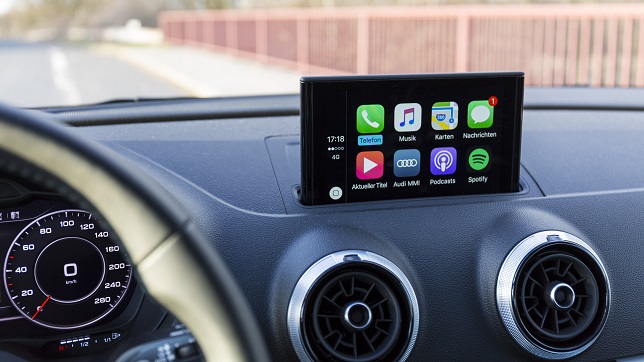Exploring Additional Revenue Streams through Vehicle Embedded Connectivity

The global connected vehicle market is growing and is expected to reach 200B USD by 2027. A connected vehicle by definition has the ability to connect to a network for bi-directional communication between vehicles, mobile devices, and IT infrastructure to facilitate triggering of important communication and events. Intelligence gathered through connectivity leads to diverse use cases in the connected vehicles space that results in safe driving environment, efficiency in vehicle performance and better consumer experience. In this article, we are going to focus on how connected vehicle can offer better consumer experience which would open the doors for Automotive OEMs to additional revenue streams.
Firstly, let understand the types of connectivity available in a connected vehicle. There are primarily two types of connected mobility solutions – tethered and embedded. Tethered connection would mean connecting the vehicle to a mobile phone or device through which the user can get services limited to the ones available in the mobile phone or device like GPS navigation and hands free calling. The connectivity in a tethered connection is managed by the mobile phone or device, which means the connectivity would be lost if the mobile phone or device goes out of network range. Contrary to tethered connectivity, embedded connectivity as the name suggests is not dependent on an external mobile phone or device. Instead, the connectivity is provided through the modem of the telematics control unit (TCU) built inside the vehicle that ensures a constant steady connection to the cellular network leading to better user experience through additional use cases. This guarantee of constant connectivity coupled with enriching user experience is leading to increased adoption of embedded connectivity globally. The uptake of embedded connectivity in the connected vehicle space is leading Automotive OEMs to embed additional services like music streaming, GPS navigation, video players, hands-free calling, WiFi hotspot, usage based insurance, concierge services, and many others that provide a more richer user experience. Let’s explore some of these services:
- WiFi hotspot – Automotive OEMs are offering in-vehicle embedded WiFi hotspots which enable passengers to connect their devices to the internet without using their mobile data connectivity. Passengers have the option of choosing the data plan based on their consumption requirements which enable them to have the at home WiFi experience inside their vehicle
- GPS Navigation – Instead of depending on the mobile handset for navigation, GPS navigation systems are being embedded in the vehicle which uses the vehicle’s embedded connectivity to provide navigation support to the passenger towards their desired destination. The embedded navigation system also provides access to real time traffic information, weather, and local search.
- Marketplace Services – Automotive OEMs are embedding applications which provides a marketplace on the passenger’s vehicle dashboard which enables the passenger to download white-label or 3rd party applications related to music streaming, audio books, social network, and location sharing. It is possible for the passenger to even order coffee, pay for the fuel at selected gas stations, and able to make a travel booking with their chosen travel service provider
- Usage Based Insurance (UBI) – The service incentivizes the user for safe driving practices where the insurance price is dependent on the driving behavior. The UBI device embedded in the vehicle tracks the driver’s driving behavior and pattern, based on which the insurer provides reduced premium for customers and can automate the claim process thus providing a better customer experience
- Concierge Services – With a steady connectivity channel that can support terabytes of data exchange, the connected vehicle industry is paving the way for driver concierge services. A few examples of such services are as follows:
- Dispatching emergency service first responder to the vehicle that has got into accident, where the vehicle reports its location and status of the different parts of the car
- Remotely analyze the attributes of a vehicle that has broken down and recommend the necessary action without towing the car to a nearby garage
- Ability to receive package delivery at the trunk of the car without the driver being physically present
- On demand services like car wash and fueling where the vehicle doesn’t need to drive to the service and instead the service comes to the vehicle based on preordering of such services
With a clear value proposition of these services towards the consumers, Automotive OEMs have an opportunity to create additional revenue streams by monetizing such services. In this section of the article, we will explore the technical landscape required by the Automotive OEMs to offer such services as well explore how these services can be monetized in an effective manner
From a technology enablement point of view, Automotive OEMs need to look at the following:
- Isolating the infotainment data channel – Data generated by a connected vehicle can be categorized broadly into 2 categories – telematics, and infotainment. Telematics data primarily provide information related to vehicle diagnostics and are directed towards the Automotive OEMs’ connected vehicle cloud. Infotainment data on the other hand is directed towards cloud services that offer the respective infotainment services. From the perspective of cellular network, the destination of the connected vehicle data is guided by the Access Point Name, commonly known as APN. This means that telemetry data will be sent to the APN representing the Automotive OEMs’ connected vehicle cloud and infotainment data will be sent to the APN representing the cloud service of the respective infotainment services. This capability to extract the infotainment data channel provides an opportunity to the Automotive OEM to innovatively monetize this data channel for additional revenue streams
- Payment GW integration – This would allow the user to purchase a connectivity plan or a service on the spot from their vehicle dashboard by using their credit card information. Depending on the country of operation, Automotive OEMs need to ensure that the payment GW is compliant with the local regulatory requirement
- Creating partnerships – In order to provide bundled services with connectivity, Automotive OEMs need to establish partnerships with multiple service providers across different services. Alternatively, they can build partnerships with connected car service providers that offer a single stop shop for multiple infotainment services. The richness of this partnership ecosystem will help the Automotive OEMs to provide a unique differentiator towards their consumers
- Building a Consumer Storefront – Automotive OEMs need to provide a consumer storefront through which it is going to display the bundle connectivity plans and services to the target user. The storefront will be integrated with the backend CRM system where the bundle connectivity plans and services would be managed and provides tools for revenue reconciliation between different service providers of that particular service ecosystem
From a monetization standpoint, Automotive OEMs can explore the following possibilities:
- Reselling connectivity – Automotive OEMs would get into a wholesale connectivity agreement with the telecom service provider and independently price connectivity plans to the consumers. As part of the service contract with the consumer, the Automotive OEM would be responsible to offer connectivity services and its associated bundled services to the consumer
- Automotive OEMs can explore revenue share plans with the Telecom Service Providers for the following scenarios:
- Prepaid Data – The telecom service provider can present bundled connectivity prepaid plans to consumers who are not their existing customers, which they can purchase and use till the balance and/or validity expires
- Shared Mobile Data – The telecom service provider can offer mobile data sharing plans to their existing customers, which will allow them to allocate a certain portion of their allocated data to automotive connectivity
- Sponsored Data – Automotive OEMs can offer data and bundled services to consumers that are sponsored by different merchants. While the merchant pays the telecom service provider for this data, Automotive OEMs can negotiate a revenue share with the telecom service provider for this data consumption
There lies a clear value proposition for these consumer connectivity services. In addition to new revenue streams, these services enable the Automotive OEMs to increase consumer stickiness through enhanced consumer experience and create an unique differentiator in the market. With increase in connected vehicle rollout, increased adoption of embedded connectivity, and a rising demand of entertainment on the go, Automotive OEMs are uniquely positioned to rollout innovative consumer connectivity services which they can effectively monetize to create additional revenue streams for themselves.
Author:

Tirthankar Guha
IoT Go To Market Manager
Ericsson Canada
Tirthankar is the Go to Market Manager at Ericsson for the IoT Connectivity portfolio based in Montreal, Canada. He is responsible for driving the global Go to Market strategy for some of the key offerings within Ericsson’s IoT Connectivity portfolio towards Ericsson’s CSP Partners and Enterprise Customers across different industry verticals.
Published in Telematics Wire


